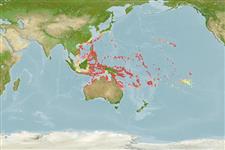Actinopterygii (ray-finned fishes) >
Perciformes (Perch-likes) >
Chaetodontidae (Butterflyfishes)
Etymology: Heniochus: Greek, enioi, -ai, -a = sometimes, some + Greek, oche = food (Ref. 45335).
Environment / Climate / Range
Ecology
Marine; reef-associated; depth range 2 - 30 m (Ref. 90102). Tropical, preferred ?; 35°N - 23°S, 105°E - 137°W
Pacific Ocean: Indonesia to the Society Islands, north to southern Japan, south to Rowley Shoals and New Caledonia; throughout Micronesia. Reported from Christmas Island in the eastern Indian Ocean (Ref. 5439). Replaced by Heniochus pleurotaenia in the Indian Ocean (Ref. 37816).
Size / Weight / Age
Maturity: Lm ? range ? - ? cm
Max length : 19.0 cm TL male/unsexed; (Ref. 9710)
Occur in deep lagoons and steep outer reef slopes, with mixed algae and coral growth (Ref. 48636). Solitary or in small groups. Feed on corals and other invertebrates (Ref. 9710). Oviparous (Ref. 205). Form pairs during breeding (Ref. 205). Maximum depth reported taken from Ref. 48636.
Life cycle and mating behavior
Maturity | Reproduction | Spawning | Eggs | Fecundity | Larvae
Form pairs during breeding (Ref. 205).
Myers, R.F., 1991. Micronesian reef fishes. Second Ed. Coral Graphics, Barrigada, Guam. 298 p. (Ref. 1602)
IUCN Red List Status (Ref. 115185)
CITES (Ref. 94142)
Not Evaluated
Threat to humans
Harmless
Human uses
Fisheries: minor commercial; aquarium: commercial
More information
ReferencesAquacultureAquaculture profileStrainsGeneticsAllele frequenciesHeritabilityDiseasesProcessingMass conversion
Tools
Special reports
Download XML
Internet sources
Estimates of some properties based on models
Phylogenetic diversity index (Ref.
82805): PD
50 = 0.5039 [Uniqueness, from 0.5 = low to 2.0 = high].
Trophic Level (Ref.
69278): 3.2 ±0.3 se; Based on diet studies.
Resilience (Ref.
69278): High, minimum population doubling time less than 15 months (Preliminary K or Fecundity.).
Vulnerability (Ref.
59153): Low vulnerability (14 of 100) .
